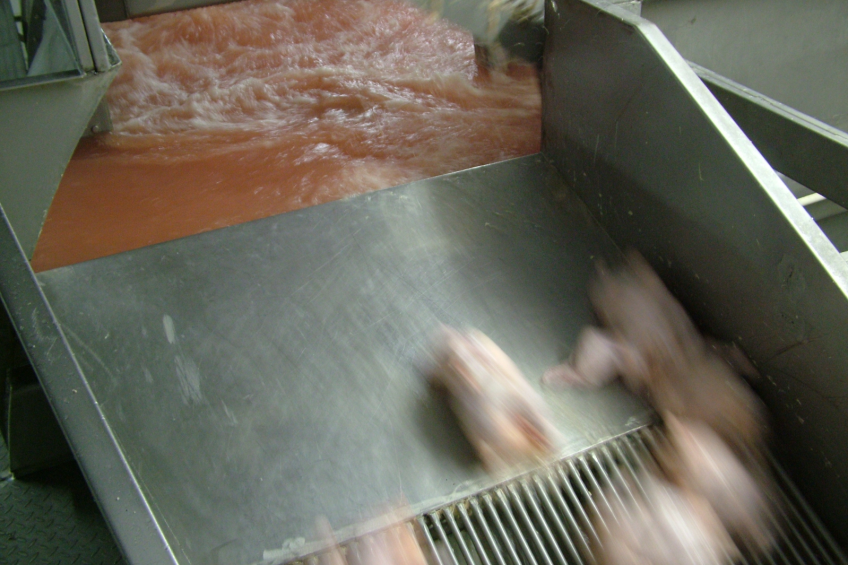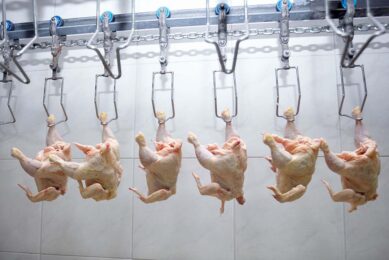Saving water in the processing plant

Millions of litres of water are used in a processing plant annually. But water is a costly and scarce production factor. Savings can be made easily however, to reduce the amount of litres per bird. ?This will save water and reduce the cost per kilo of processed chicken.
By Eduardo Cervantes Lopez, processing consultant, Barranquilla, Colombia
Processing chickens is less water consuming then the processing of mammals. Yet, despite this positive reality, the broiler industry is aware of its great social responsibility to reduce consumption of this valuable liquid. After all, the world’s water resources are becoming increasingly scarce and expensive. The management of a processing plant should therefore explore new opportunities for lowering the use of water. Not just that, but also ensure proper sanitary conditions to obtain a good and safe final product: the processed chicken.
Opportunities for improvement
The philosophy of processing more chickens with less water, demands that all personnel should permanently and closely observe the details of their work. An example is to thoroughly wash a chicken. This doesn’t need large amounts of water, but a suitable pressure of 25-30 psi instead. Furthermore the infrastructure. Pipelines for water must be designed in accordance with the operation: processing, plant wash, toilets, etc.
The water supply should be monitored permanently during the process, to ensure that no waste water leaks or incorrect adjustments are made during maintenance work. Also an important measure is the re-use of processing water in complementary operations. Finally new sources of water supply should be explored, i.e. ground and/or rain water.
Culture of saving water
It is proven that the eyes do not observe what the brain does not fully know. Therefore, in many plants water consumption per chicken is high due to the reasons below.
Firstly, it is believed that a good wash requires using a lot of water. For this reason, many plants are using showers.
Secondly, once the first chicken has been hung in the overhead killing conveyor, scalding is put into service simultaneously, as well as plucking and washing machines. The overhead evisceration conveyor and all showers to wash the chickens can easily be started later however, as they come to this section only about 10 minutes later.
The infrastructure for water transport before, during and after processing is also an important matter. At this point it is important to remember that the plant can use water with different characteristics:
- Potable water for processing of the birds
- Processed (re-used) water that is subjected to a basic treatment, like washing the areas where chickens are stored who are waiting for processing.
Industrial water is suitable to supply boilers and some refrigeration equipment.Altogether it is important to realise that several pipe networks for different kinds of water should be used.
No monitors
The successful management philosophy of Japanese car maker Toyota is called “Gemba”. This philosophy can also be applied in poultry processing by monitoring the process on the workplace, rather than have monitors in offices that only show different process sections.
During plant visits it becomes clear that most of the time no one is reviewing the images on these monitors. Therefore, the goal to monitor in real time is not met. As a result, there is always waste water due to:
- Broken hoses without control valves
- Hoses or connections to pipes and pluckers that are not adjusted properly
- Valves that have worn seals. Consequently, when turned off, they keep dripping
- Some scalders or chillers have leaks which occur at the junctions of the modules. Sometimes poor welding also may cause leakage that keeps going for several days.
Proper infrastructure
As stated earlier, it is important to understand that the plant has various pipe networks for the following purposes:
- Processing: Drinking water which is used for filling the tub stunner, scalder and chillers for both chickens and offal.
- Equipment and facilities: Drinking water. These pipes should have a fast couplings system, similar to those in the compressed air system, used for the vent cutter, neck cutter, crippler bags etc. This design keeps the hoses intact.
- In the storage areas where the birds are waiting to be killed and the area where they are hung in the overhead slaughter conveyor: Re-used water should be used. This separate pipe is connected to a tank where a portion of the wastewater that has received a primary treatment in order to reduce solids (feathers, intestines, etc.) and fat. Taking out this fat can be done using the “DAF” technology. This water can also be used for flushing toilets.
- Water supply to boilers and refrigeration equipment: Re-used water. For this purpose, the residual water after passing through the DAF system, continues through Tri-Decanter technology (separating fat, solid and water). It is important to also monitor the pH and hardness of the water, to prevent fouling problems that are gradually formed in the pipe and the equipment.
- The blood tunnel design should have very special characteristics, to take advantage offered by the blood of chickens: clotting time is much greater than that of mammals. Therefore, no water is needed to lead blood to the respective storage tank to be then pumped to the rendering plant.
Corrective actions
The use of “Gemba” monitoring allows to observe, evaluate and take corrective actions in real time effectively. It allows responsible managers to always be on the job, enabling tracking of the following processes:
- When the processing starts early in the day, all stages and machines in the line must run sequentially. As chickens are moving through every machine, the respective water control valves must be opened.
- Monitor the initial filling water level of the scalder, pre-chiller and chiller of carcasses and giblets to avoid, when the agitation system starts, that the water is not going to bounce. This situation becomes more critical when added ice to chillers and carcasses and giblets begins to move into these machines.
- A special pipe nozzle to wash the chickens and their giblets during the evisceration is advisable.
Major savings possible
Some plants already have special tanks or ponds to store rain water at no cost. Depending on the application in the plant, it can be used in several of the above mentioned processes. In summary, depending on the size, the technology used and the infrastructure of the plant, water consumption in Latin America (except for Brazil), ranges between 12 to 18 litres per chicken.
If the aforementioned and other creative ideas are implemented, minimum savings of four litres of water per chicken can be achieved. Assuming a daily processing of 100,000 birds, savings of 400,000 litres, or 400 cubic meters represent approximately 125,000 cubic meters a year. This vast amount of water will have a positive impact on reducing the operating costs of the waste water treatment plant and processing plant, helping to reduce the cost per kilo of processed chicken.
Join 31,000+ subscribers
Subscribe to our newsletter to stay updated about all the need-to-know content in the poultry sector, three times a week. Beheer
Beheer








 WP Admin
WP Admin  Bewerk bericht
Bewerk bericht